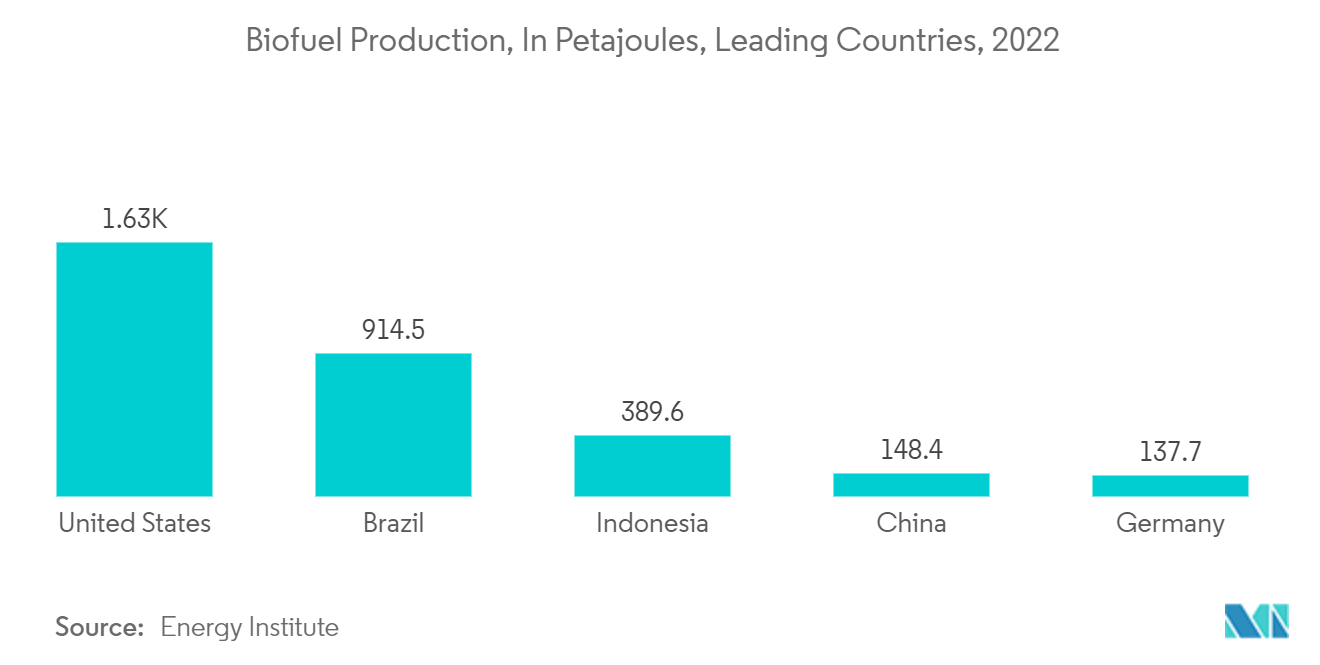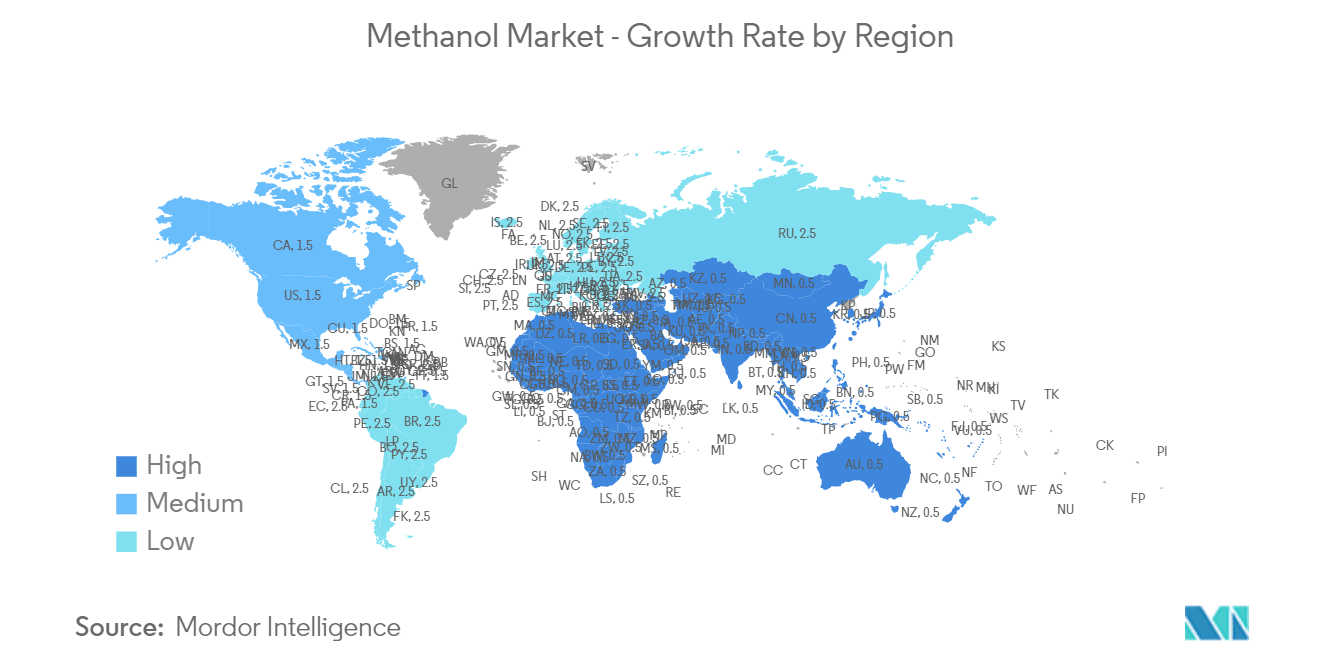Market Trends of Methanol Industry
Energy-related Applications to Dominate the Market
- The use of methanol in energy-related applications has increased significantly in the past few years. Methanol is widely used in methanol-to-olefins (MTO) transformation reactions, which provides a chance to produce basic petrochemicals (such as ethene, propene, butene, and butadiene) from non-oil resources like coal and natural gas.
- Methanol is a precursor for producing methyl tertiary-butyl ether (MTBE), which is added to gasoline to enhance the octane number by increasing the oxygen content. MTBE leads to the complete combustion of gasoline and, thus, lowers the exhaust of harmful gases, like carbon monoxide and other emissions from vehicles, reducing air pollution.
- Methanol has been successfully used to extend gasoline supplies in many gasoline markets worldwide. Adding methanol to the gasoline supply provides non-petroleum alternative energy and a clean-burning, high-octane fuel. According to the Methanol Institute, unlike other alcohols, methanol blending in gasoline has been economical without government subsidies or fuel-blending mandates.
- Moreover, the demand for oil products such as gasoline is expected to increase year-on-year. For instance, the global demand for gasoline is anticipated to reach 28.2 million barrels per day in 2030, registering a 9.7% increase over 25.7 million barrels per day in 2021, according to the Organization of the Petroleum Exporting Countries (OPEC).
- Methanol is also used to produce dimethyl ether, which registers significant usage as a fuel substitute due to its good ignition quality and high cetane number. DME in diesel engines burns very cleanly with no soot. It can be used in diesel engines as a substitute for conventional diesel fuel.
- Methanol is a crucial starting material for the production of biodiesel, which is viewed as an alternative renewable fuel for crude oil-derived diesel. Methanol is preferred over ethanol for the transesterification reaction due to its superior reactivity with triglycerides and high alkaline dissolution properties.
- Biodiesel is a clean burning fuel that increases energy security and leads to a lower carbon footprint. It exhibits a higher flash point (100°C minimum) and can be blended with diesel fuel at any proportion; both fuels can be mixed during the fuel supply to vehicles. The environmental benefits of biodiesel have spurred the continued increase in biodiesel production in the historical years, except for 2020, when the pandemic was at large.
- According to the Organisation for Economic Co-operation and Development (OECD), the global consumption of biofuels, including biodiesel, is expected to register a growth of 13.1% to reach 210.7 billion liters in 2029 compared to 186.35 billion liters in 2022. The increasing production and consumption trend in biofuels such as biodiesel is likely to increase the share of methanol consumption in biodiesel production during the forecast period.
- Considering all the abovementioned factors, the use and demand of methanol for energy-related applications are expected to grow in the forecast period.

Asia-Pacific Region to Dominate the Market
- The Asia-Pacific region dominated the worldwide market with a significant market share. It is projected to maintain its dominance during the forecast period. China alone is the largest producer and consumer of over 60% of the world's methanol, making the country the world leader. In Anyang, Henan Province, China, a 'cutting-edge' carbon dioxide-to-methanol plant has begun production, becoming the world's first commercial-scale facility to manufacture methanol from captured waste carbon dioxide and hydrogen gases.
- According to the Methanol Institute, methanol powers up to 7 million automobiles in China, contributing to more than 5% of the country's fuel pool. Methanol emits 26% less carbon dioxide than conventional gasoline-powered automobiles, even when generated primarily using coal-based techniques. The Chinese Ministry of Industry and Information Technology announced plans to "increase the popularity of methanol automobiles" and study the 'green methanol + methanol cars' concept.
- In India, NITI Aaayog designed a strategy to replace 10% of crude imports with methanol alone by 2030. This takes about 30 MT of methanol. Methanol and DME are significantly less expensive than petrol and diesel; India expects to lower its fuel expense by 30% by 2030.
- Japan is home to some major automotive producers, including Kawasaki, Yamaha, Toyota, Honda, Nissan, and Suzuki, who are planning to develop vehicles that use methanol as fuel. The National Energy Strategy of Japan focuses on reducing petrol dependency from 50% to 40% by 2030, improving energy efficiency by 30%, and replacing 20% of transport fuel with an alternative fuel, such as methanol, enhancing the demand in the market studied.
- Singapore is the most recent country to join the ongoing efforts to establish a worldwide infrastructure for producing and distributing methanol as a marine fuel. Singapore, which is already recognized as the world's largest bunkering center for the shipping sector, is set to become the first green e-methanol facility in Southeast Asia, a collaboration between the shipping and fuel industries.
- All the abovementioned factors are expected to fuel the growth of the methanol market in the Asia-Pacific region over the forecast period.

